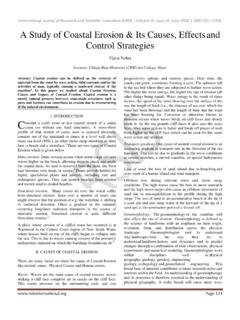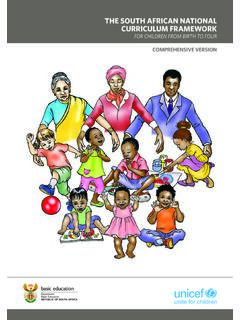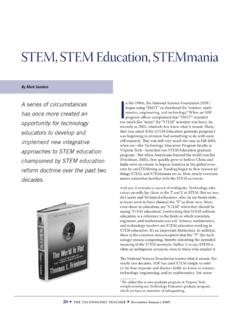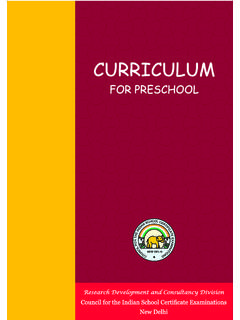Transcription of Implementation of the Zambia Education Curriculum ...
1 International Journal of Research and Innovation in Social Science (IJRISS) |Volume V, Issue II, February 2021|ISSN 2454-6186. Implementation of the Zambia Education Curriculum Framework - 2013 at Early Childhood Education : A. case of selected Primary Schools in Western Province, Zambia Mushinga Kapelwa Mooto Department of Education & Professional Studies, Mongu College of Education Mongu, Zambia Abstract: The study investigated the Implementation of the I. INTRODUCTION. Zambia Education Curriculum Framework (ZECF) - 2013 at Early Childhood Education (ECE) level in selected primary schools of Western Province, Zambia . The Objectives were to explore how the ZECF - 2013 was being implemented at ECE. A t the birth of the new Republic of Zambia in 1964, there was a shift from a colonially designed Education system to a system that was subtended on equality.
2 The color bar that level and to identify the challenges faced by teachers in punctuated colonial Education was consequently broken. implementing the ZECF - 2013 at ECE level in the Primary Certain policy pronouncements and undertakings had to be Schools. The study was a descriptive case study within taken and put in place. The Education Act of 1966 overhauled qualitative school of thought. It targeted the ECE teachers, Head the whole Education system of the country to meet the teachers and Education Standards Officers. Sampling was done purposively. The type of purposive sampling used for all the aspirations of the newly independent country. The primary target population was stakeholder sampling. The sample size was and secondary school Curriculum was diversified and 61.
3 The distribution of the sample was 26 ECE teachers, 26 head standardized while the secondary school Curriculum was teachers and 09 Education Standard Officers. Semi structured aligned with the demands of the United Nations Educational, interviews were used to collect data from Head teachers and Scientific and Cultural Organization (UNESCO). However, it Education Standards Officers. Questionnaires were used to is noted that at that time, Early Childhood Education , which collect data from the ECE teachers. Document analysis used was offered within the mainstream Education as Substandard teachers teaching files, school time tables, learner assessment A and B was removed (CDC, 2013). ECE was to be offered at records, classroom inventories etc.
4 Data analysis made use of the discretion of Social Welfare Departments by local themes arising from the data. Findings were that few teachers had minimum qualifications for ECE teachers. Implementation authorities, local communities, and non-governmental was in situation of inadequate classroom space, teaching staff organizations. and teaching and learning materials. The recommended In 1977 the country had the Educational Reforms (MOE, Assessment tool was not used. The use of the familiar language as 1977) that came in with more changes to the Education medium of instruction was adhered to. Child Play was not emphasized. Integrated approach to teaching and planning to system. As regards ECE, the Education Reforms emphasized teach was not familiar to teachers and not used.
5 Conclusion was that ECE was intended for children below the age of seven that demands of ZECF 2013 were not fully adhered to. who normally will not have started full time Education . Inadequate classroom space meant that aspects of ECE learning However, and most importantly, the Education Reforms stated and routine suffered. Areas of child development and that ECE was not going to be available to every child for a establishment of development patterns in children suffered due long time to come (MOE, 1977: 8). The national Education to improper assessment. Language development & Primary policy; Educating our Future (MOE, 1996), reiterated the Literacy Program is bound to succeed. Holistic Child significance of ECE in the development of the child.
6 Again, development was undermined. The study recommends that there was admission that only a small minority of Zambian satellite ECE centers under the management of the nearest primary schools be constituted using cheap and local materials so children were able to benefit from the Education at that level. as to decongest the primary schools grappling with inadequate Furthermore, the Education Policy document re-emphasized resources. Rigorous CPD programs should be instituted to align that the provision and funding of Early Childhood and Pre- the teachers with the demands of ECE teaching and the ZECF school Education would be the responsibility of councils, 2013. local communities, non-governmental organizations, private Keywords: Child Play, Integrated Approach, Assessment, Early individuals and families (MOE, 1996).
7 Childhood Education Save for a few policy pronouncements and declarations, the milestone document in the Education provision in the recent past was the Zambia Education Curriculum Framework 2013. Page 512. International Journal of Research and Innovation in Social Science (IJRISS) |Volume V, Issue II, February 2021|ISSN 2454-6186. (CDC, 2013). The outcome of that move was that Pre-school III. RESEARCH OBJECTIVES. Education which was since independence decentralized and The study was guided by the following research objectives: that each local government had to design and develop its own system of providing ECE was to fall directly under the To explore the Implementation of the Zambia Ministry of General Education . Consequently, there was to be Education Curriculum Framework 2013 at Early a standardization of what had for a long time been an Childhood Education level.
8 Uncoordinated, fragmented and substandard ECE. Additionally, the ZECF - 2013 dictated that newly introduced To identify the challenges faced by teachers in ECE, like lower primary school grades, was to make use of implementing the Zambia Education Curriculum the local language as a medium of instruction. Contrary to the Framework 2013 at Early Childhood Education level. spirit of Education Reforms of 1977 which indicated that IV. REVIEW OF RELATED LITERATURE. Preschool teachers would not be employed by the Ministry of General Education but by the Local Authority or the ECE and Primary School Dichotomous setup and proprietors of the pre-school (MOE, 1977: 75; UNESCO, Management 2006), the ZECF - 2013 provided for the employment of ECE In the study by Kilgallon, et al (2008), it was revealed that the teachers in the Ministry of Education .
9 Dichotomy in some schools of Australia where primary Pursuant of the aspiration as contained in the ZECF - 2013 schools and ECE existed within one institution, line managers (CDC, 2013) each primary school was to have an ECE section did not give enough support in coping with the daily demands and that more ECE teachers were to be trained and deployed of ECE. Given that the ZECF - 2013 provides for the into the mainstream Education system. Almost a decade after inclusion of ECE within the existing primary school setup;. the Implementation of the ZECF - 2013 (CDC, 2013), there which is actually the dichotomy that is stated the study by was need to study the Implementation of the said ZECF - 2013 Kilgallon, et al (2008), there was need to explore the manner in selected Primary schools of Western Province.
10 The ZECF - 2013 was being implemented. II. STATEMENT OF THE PROBLEM Mafora and Phorabatho (2013: 117) did a study on the capability of the principals of school in Moretele Area of From independence, ECE fell under the Ministry of Local North West Province; South Africa in implementing the Government and each local authority had its own curricula. national Curriculum Statement. The findings of the study ECE was not available to all the children in the country indicated that principals of schools struggled with the (MOE, 1977; MOE, 1996). In response to the MOE Strategic Implementation of the national Curriculum Statement as a Plan 2003 2007, the Fifth national Development Plan 2006 Curriculum Change. The study revealed that they had 2010 and the national Educational Policy Document 1996, inadequate knowledge about managing a complex Curriculum the government, in 2013, produced a document of the review and that the situation was worsened by lack of resources like of the Curriculum which was titled the ZECF - 2013.










